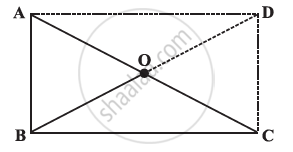Advertisements
Advertisements
Question
For which of the following figures, diagonals are equal?
Options
Trapezium
Rhombus
Parallelogram
Rectangle
Solution
Rectangle
Explanation:
By the property of a rectangle, we know that its diagonals are equal.
APPEARS IN
RELATED QUESTIONS
ABC is a right-angled triangle and O is the mid point of the side opposite to the right angle. Explain why O is equidistant from A, B and C. (The dotted lines are drawn additionally to help you)

In a parallelogram ABCD, the diagonals bisect each other at O. If ∠ABC = 30°, ∠BDC = 10° and ∠CAB = 70°. Find:
∠DAB, ∠ADC, ∠BCD, ∠AOD, ∠DOC, ∠BOC, ∠AOB, ∠ACD, ∠CAB, ∠ADB, ∠ACB, ∠DBC and ∠DBA.
In Fig. 17.29, suppose it is known that DE = DF. Then, is ΔABC isosceles? Why or why not?
Which of the following statement is true for a rectangle?
It has two pairs of equal sides.
The sides of a rectangle are in the ratio 4 : 5. Find its sides if the perimeter is 90 cm.
Draw a square whose each side measures 4.8 cm.
A mason has made a concrete slab. He needs it to be rectangular. In what different ways can he make sure that it is rectangular?
If the diagonals of a parallelogram are of equal lengths, the parallelogram is a rectangle. Prove it.
Every trapezium is a rectangle.
Quadrilateral EFGH is a rectangle in which J is the point of intersection of the diagonals. Find the value of x if JF = 8x + 4 and EG = 24x – 8.
